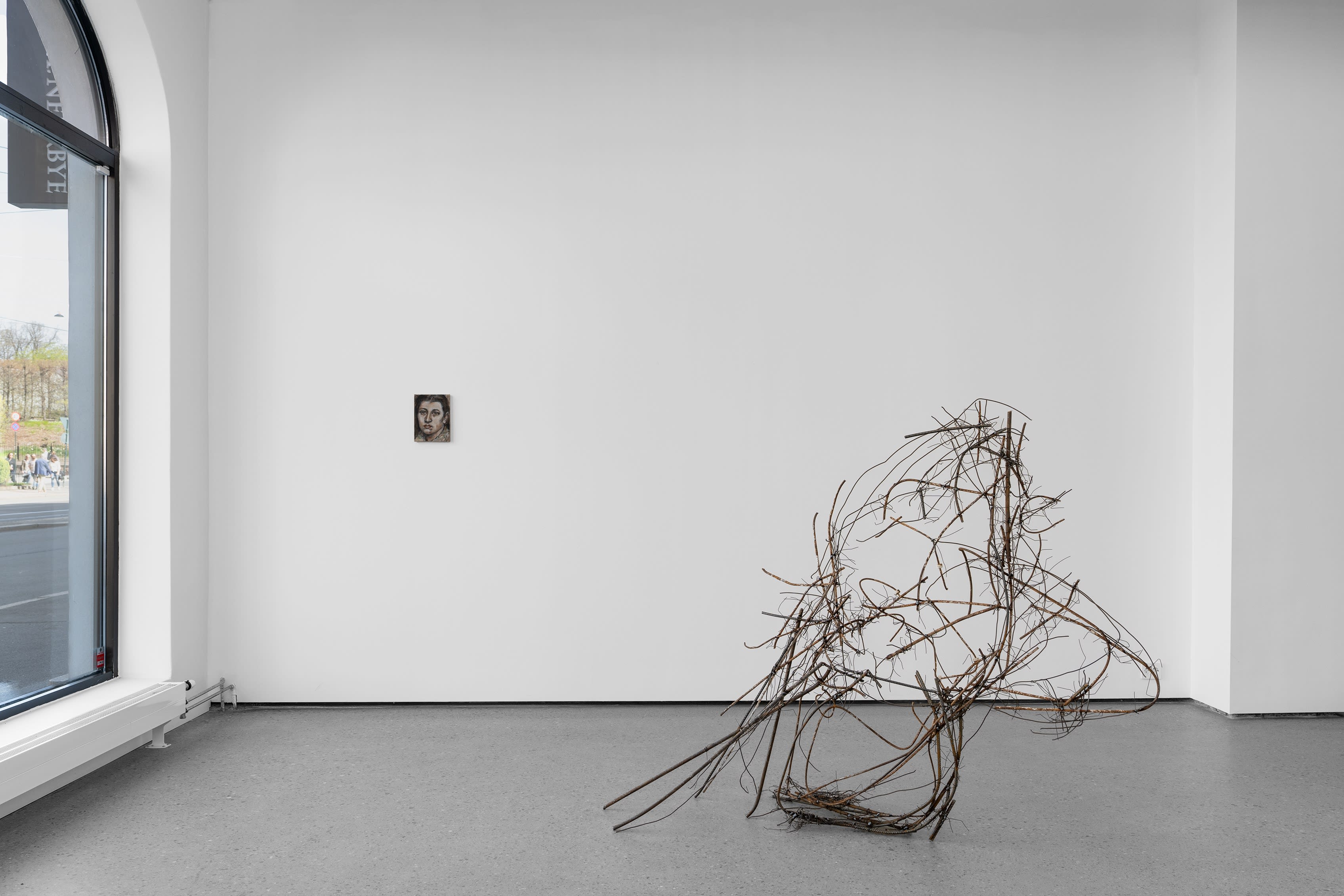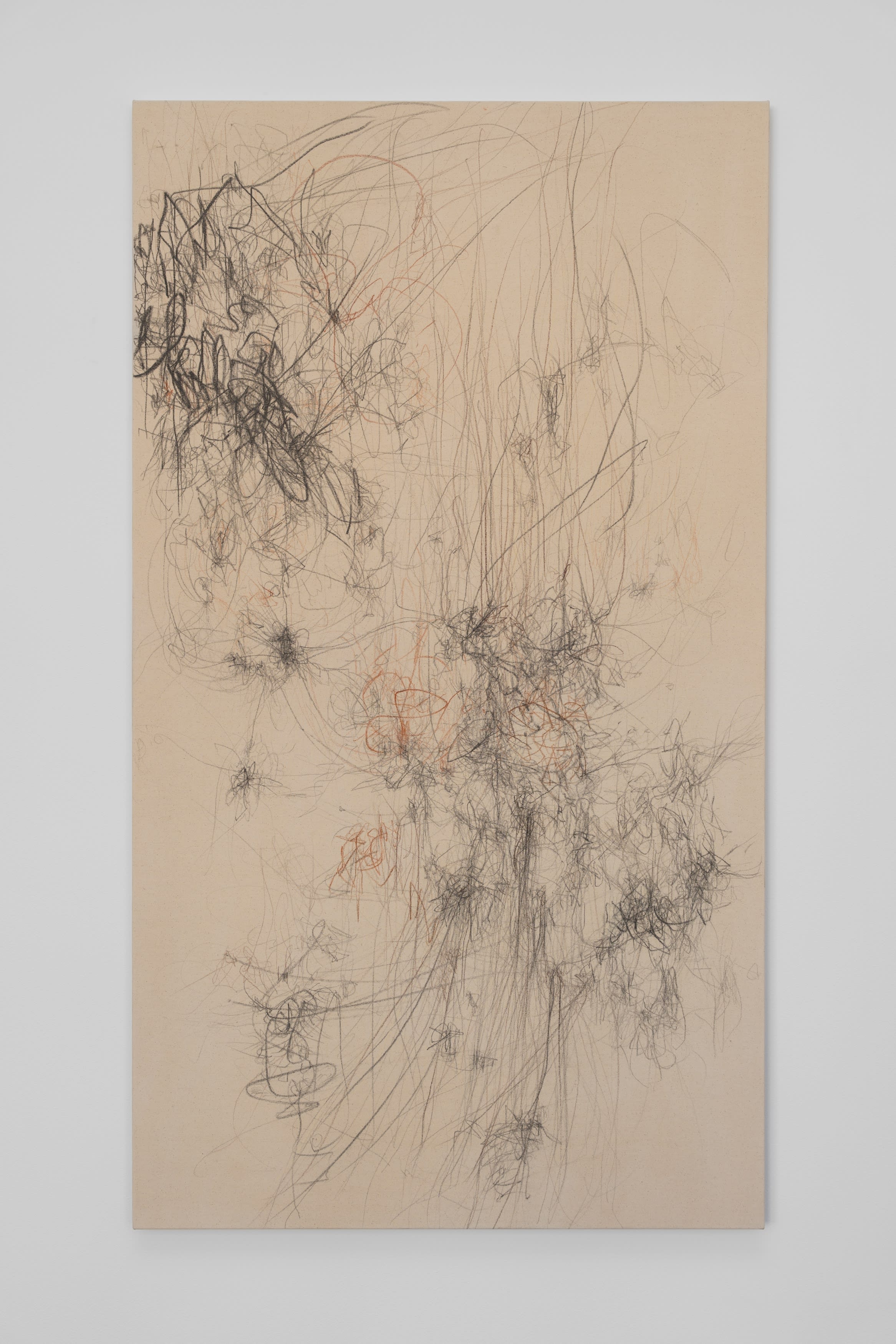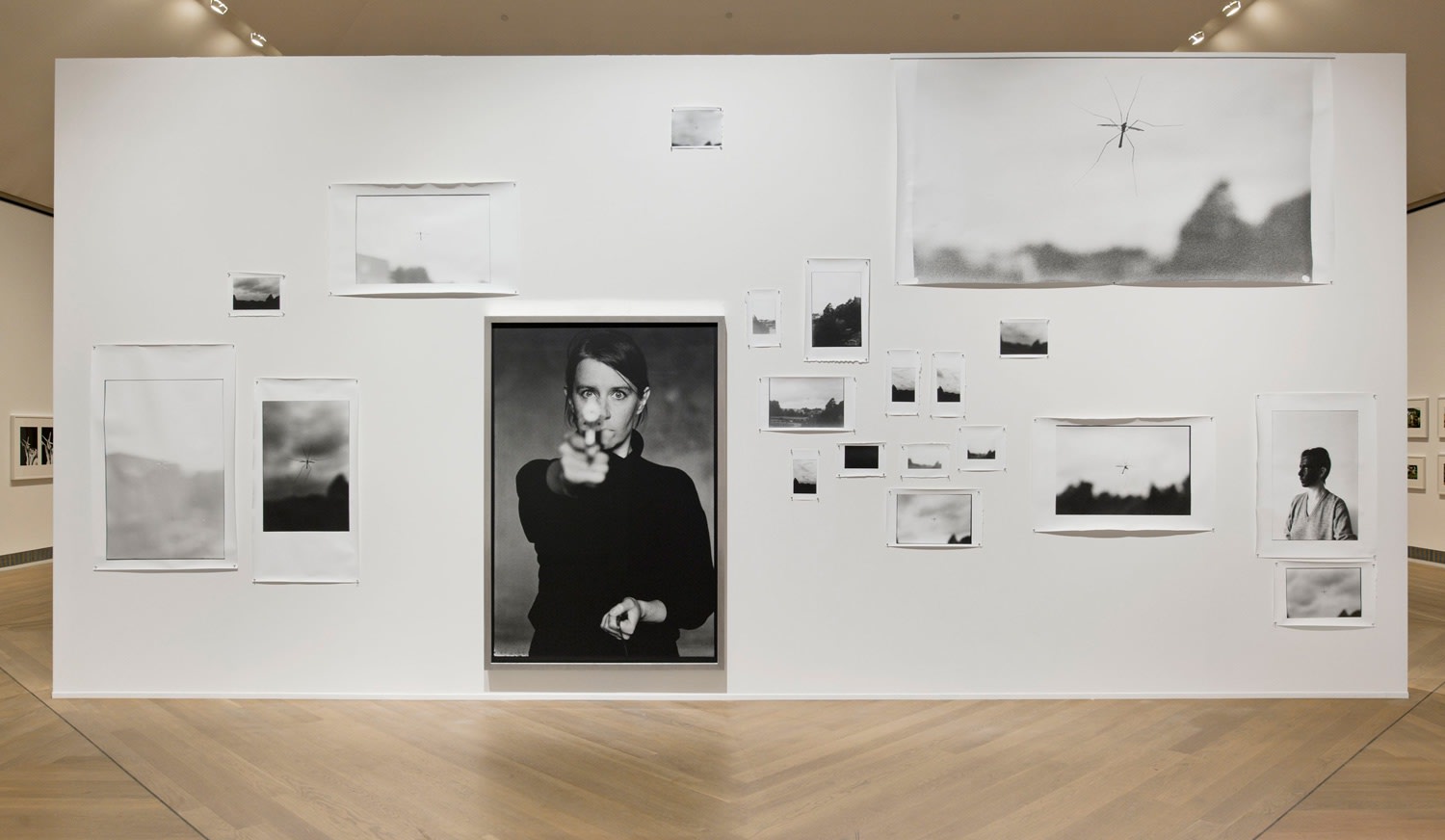We are excited to present a conversation between Evelina Hägglund and Yves Scherer, on the occassion of Hägglund's show, I dreamt I was the ground. Scherer, a Swiss artist who has done multiple solo shows at the gallery, is the one who introduced Evelina's work to the gallery. This conversation delves into Evelina’s rich personal history, artistic journey, and the themes that shape her artistic practice.
Yves Scherer (Y): You have a very interesting personal biography. Could you elaborate a bit?
Evelina Hägglund (E): I'm the daughter of two Baptist pastors and grew up in concrete suburbs on the outskirts of Stockholm, where people from around 100 countries live. These suburbs are places where no one really has roots, either because they moved to Stockholm for work from elsewhere in Sweden or because they came as immigrants or were children to these people. When I was about 12, my parents divorced, transferred to Lutheranism, and eventually began working as pastors in the Swedish national church instead. I myself am not religious and haven't been since I was a kid.
Skipping ahead, my teenage years were messy. I skipped school a lot. Wanting a fresh start, I left my Stockholm suburb for the US at 16, alone and barely knowing any English. I was placed with a conservative family in Kansas, who I lived with for a year. They were Christian in the way that people in their church didn't believe in the Big Bang or evolution. After that, I moved to Spain and learned a new language, culture, country, and reality. After briefly returning to Stockholm to finish high school, I spent a year in Latin America. Long story short, I then lived in Slovenia for five years, where I did my BFA, and in the UK for three years, where I completed my MFA at Goldsmiths. Two years ago, I returned to Stockholm to live for the first time since I was a teenager.
My life experience has taught me that there is always more than one truth and more than one perspective from which to tell history. I've seen firsthand how the West and the "first world" have scarred many things historically and into the present. I've also learned that every language and every small or big culture carries and reproduces its own reality. Having lived in different countries and spoken different languages, sometimes without at first knowing the local tongue, I can say that for me, there is a reality before language, before names, and before identity—a material reality that exists before all of that. This is an outsider's position in relation to unfamiliar languages and cultures, cultures one hasn't yet entered. This position, without a name, is what my work explores. It's a personal stance but also general, dealing with an experience of being outside language and culture, which is common in globalization.
Y: If I imagine the most perfectly elegant art room, it would probably be something like a Giacometti sculpture and a Brice Marden painting, and I find both elements very much in your work. It's sort of a continuation of Modern Masters but by a woman and completely with its own feeling. How do you feel about this?
E: I appreciate the idea of my work as a continuation of Modern Masters with its own distinct feeling. However, I want to address the failure of both abstraction and figuration in the 20th and 21st centuries. It's strange to me the idea to keep reproducing their work, as well as the abstract-figurative duality today. I want to let figurative and abstract work clash and coexist until something new emerges. I'm aiming for something else, something new, and third, something beyond traditional abstraction and figuration. Something that doesn't yet have a name. In this way, my work seeks to break away from the lineage of Western abstraction and figuration and their so-called Modern Masters.
At the same time, I value learning from history, and I find Giacometti's skill in "taking the fat off space" in his sculptures relatable, even though he was a complex and problematic person. Jo Widoff did a good job showcasing this complexity at Moderna Museet in Stockholm in 2020. As for Brice Marden, I have only recently become more aware of his work. Western art history, especially after WWII, saw a shift towards abstraction as a means for artists to distinguish themselves from the heroic figurative sculpture associated with Western civilization's rulers and their violence. Giacometti didn't create such work, but figurative sculpture fell out of favor post-WWII, even being dropped from academic curricula. Despite the rise of abstraction, abstraction hasn't improved the world, as evidenced by ongoing conflicts.
I believe it's time for a new fusion of abstraction and figuration, something greater than the sum of its parts. This is what I strive for in my work.

Y: I have always connected very strongly to art, and a life that feels ascetic, or maybe rudimentary, is a better word or essential. I find a lot of joy in a simple life and think there is a lot of aesthetic quality to it. In some way, that is a nostalgic notion that I try to avoid in my life, but life used to be simpler, and if you go to the countryside, it still is. And often, things are prettier there and seem more meaningful. Mainly because there are fewer of them, so each sort of fulfills a real purpose and has no replacement part. I'm not sure if I'm going off track here, but your work connects to this feeling in me. It's Art Povera-like in a sense, but it also uses the most basic or essential materials—clay, steel, graphite, nails—and not some fancy contemporary variations of it. Do you think often about the past? Or what does my statement here make you think about?
E: That is beautiful. Like you, I'm not into nostalgia or the idea that "it was better before." As you may know, my work is diaristic, informed by my personal life and the time I live in. It's the part of my diary I can't write. When I think of the past, I want a future to believe in. I find hope in repurposing things, undoing materials from modernity, and redoing them in the present. Working with rebars excavated from the foundations and walls of old factories, concrete peeled from the streets, or clay from the ground feels like changing the past to influence the present. In this way, my work reflects a wish for a better world. I so often linger between failed attempts, visions, and hope. Despite this, I'm not tied to or limited to materials with specific histories. I use whatever I find, what I'm drawn to, and what I can afford.
I'm intrigued by your thoughts on meaning and how to find it, have it, reach for it, and organize life around it. If you ask me, the search for meaning drives human history. My life and work are no exceptions. In a world full of meaninglessness, the most critical work, is work that genuinely makes sense.

Installation image, Evelina Hägglund, I dreamt I was the ground, Golsa
Y: Following the above, I think that your work is fundamentally elegant and beautiful. At the same time, it is somehow edgy, almost in a literal sense, if you think about the nails or the metal used to tie the sculptures together or the rebar per se. Does the sculpture need to feel dangerous, or do you just like the rawness of the material?
E: That's a great question. I never intended for my work to feel violent per se, but it does absorb its surroundings. Given that I am alive during a time when causing other beings pain and damage, and even killing and murder are still a thing worldwide, the work inevitably somehow reflects that. Sometimes, I guess the work captures and holds onto this sense of violence, materially.
 Installation image, Evelina Hägglund, I dreamt I was the ground, Golsa
Installation image, Evelina Hägglund, I dreamt I was the ground, Golsa
Y: One of the reasons I relate to your work is that it feels sculptural, even if it's the work you call a drawing or the realistic portraits. Or maybe it's more something I would call material in opposition to something that I would call picturesque or with an illusionary quality. Like it is about the object in the space and in the world and not some sort of metaphysical dimension or narrative. It's also not fancy, and it doesn't need good light because it's materially so sound and of the real world, no makeup that gets exposed in the sun. Do I see this correctly?
E: I feel that the distinction between material work and picturesque work, or work with an illusionary quality, is important for our conversation. You understand correctly that I think of all my work as sculptural, as material, even the paintings. For me, how something looks is only the skin of what takes up space. The image is the outermost layer of a presence, and honestly, often, it's just in the way, kind of like a border. So, I prefer not to deal with images. Or, in your words, I do not put makeup on my work, haha. I like it raw, real, physical.

Installation image, Evelina Hägglund, I dreamt I was the ground, Golsa
Y: In some ways, we have a similar practice, where multiple independent series have their inherent development and then get combined in exhibitions. For me, it's usually one or two figures or characters that the show is based around—often they are in love with each other, or there is some sort of romantic element—and then there is their environment, which could be the paintings, for example. But I wonder how this works for you. How does it come together for you?
E: It is romantic that your sculptures are often in love with each other. I agree that, in some ways, we have similar practices. My works also like each other a lot, even if they don't look like a match at first glance. You and I both make seemingly distinct series that come together in exhibitions. We are like installation artists, for lack of a better term, though we make individual objects and sculptures. I always work on several different pieces at once, so my works do not feel like separate series. I approach the same thing—wordless experience—the separation between the world and its representation—a wilderness, from different angles, in various materials.
I'm fascinated by how you create figures and their environment, their environments being flowers or paintings, for example. I admire how simply you can put this into words as well. I also work with figures in relation to the environment. But for me, the borders between inner and outer environments are extremely blurred. The inner environment is the outer, and the outer surrounding is the inner landscape. When I work, the border between the outer and inner world, the border that is my name, the border that is my skin, the borders that are surfaces of objects, the borders between different defined things, like culture and nature, for example, those borders don't exist. There is no clear distinction between me, the figures, excess language, and the environment. Everything is figurative and abstract at the same time, all fluid and flowing. That's how the work comes together, and also what you can see in the exhibition at Golsa in Oslo. Logic can fail to make sense of everything sometimes, and one has to feel how the pieces converge using one's body, feelings, and instincts.
I love sculpting models. So far, they have been friends and acquaintances who have come to the studio to pose. Sometimes, I also make and paint imagined people, which might be like self-portraits, but occasionally, it's also a mystery where people and things come from. I'm preoccupied with the body and the environment, physically. Before their names and definitions, before representing. How a body takes up space intrigues me. It's important for me to show reality this way, to make it evident that narratives are often projected onto things. People usually get stuck in patterns of telling stories and living in fixed ideas and identities, making it difficult to let something or someone, wordless or unrepresented, in.
My artistic and personal identity is not solid. I cultivate a fluid identity through which I can make many different types of work. I don't want to be singular; I want to be several and many. I research the notion of 'I,' how it's porous, and how a person's contours are often not as strong as one would think in relation to the environment and people around them.
Y: Do you have a hierarchy in your work?
E: I strive to ensure that language, encompassing words, images, and representations, doesn't dictate the work. I liberate materiality from predefined confines, creating a sanctuary for non-linguistic, undefined, raw reality to thrive. Materiality and embodiment take precedence over language, representation, and imagery.
While I do title my work, the titles function in parallel with the work, inhabiting a separate realm—the realm of language—and the titles are always open to potential alteration.

Y: What's Swedish about your work? And are there any Swedish artists you model your work or your career after?
E: Not much, really. I view national borders and identities as cultural constructs. I understand their significance for some in terms of belonging or control but personally, I identify more as a world citizen. However, Sweden has influenced my work by prompting me to contemplate belonging and the various challenging paths to it. I ask myself how I can integrate into the world differently, beyond language, national narratives, and culture. As rootless and also part of the ground, somehow.
Having lived abroad extensively, I've learned about art histories beyond Sweden's, making its art scene relatively new to me. I see the value of having idols and role models to admire; it's always nice to have someone to look up to. For the past weeks, I've been captivated by Cecilia Edefalk's work. I can't stop thinking about her Self-portrait with a gun from 1993, when she aimed a gun at the camera lens, addressing, threatening, the image of herself. That's genius. At 69, she's having a remarkable career, both nationally and internationally.

Cecilia Edefalk, Portrait, wall installation, 2011 © Cecilia Edefalk
Y: Are there any artists that I or the audience should take a look at?
E: Olga Jevrić. She was a musician before she started making sculptures. Music must have taught her about directness because her work communicates emotion and pain incredibly directly. I admire that. I want to make work so immediately affective and effective that it just goes into the body, skeleton, and heart, just like music does.
Y: How did studying in London affect your practice?
E: During my MFA at Goldsmiths from 2019 to 2021, COVID-19 dominated much of the studies. This meant that my classmates and I were making work amidst uncertainty about whether there would be an art world at all to embrace us post-graduation. This situation made me approach my work with even greater sincerity. I recognized that my practice might only exist as a thing between myself, the world, and time. I have to admit I'm very happy I get to share it with an audience now.

Installation image, Out of Language, MFA Degree Exhibition, Goldsmiths, London, 2021
I dreamt I was the ground is on until June 29th.


